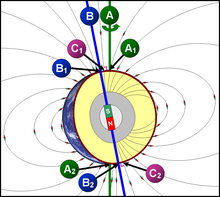Geographical pole

A geographical pole is either of the two points on a rotating body (planet, dwarf planet, natural satellite, sphere...etc.) where its axis of rotation intersects its surface.[1] As with Earth's North and South Poles, they are usually called that body's "north pole" and "south pole", one lying 90 degrees in one direction from the body's equator and the other lying 90 degrees in the opposite direction from the equator.
Every planet has geographical poles.[2] If, like the Earth, a body generates a magnetic field, it will also possess magnetic poles.[3]
Perturbations in a body's rotation mean that geographical poles wander slightly on its surface. The Earth's North and South Poles, for example, move by a few metres over periods of a few years.[4] As cartography requires exact and unchanging coordinates, the averaged[citation needed] locations of geographical poles are taken as fixed cartographic poles and become the points where the body's great circles of longitude intersect.
See also
References
- ^ Kotlyakov, Vladimir; Komarova, Anna (2006). "pole; geographic pole". Elsevier's dictionary of geography : in English, Russian, French, Spanish and German (1st ed.). Elsevier. p. 557. ISBN 9780080488783. Retrieved 22 June 2015.
- ^ Hooper, William George (2008) [1st pub. 1903]. Aether and Gravitation. Medprintor. p. 224. ISBN 978-1-4505-8550-7. Retrieved 6 January 2020.
- ^ Tarlach, Gemma (18 November 2014). "20 Things You Didn't Know About... the North Pole". Discover Magazine. Retrieved 6 January 2020.
- ^ Lovett, Richard A. (14 May 2013). "Climate change has shifted the locations of Earth's North and South Poles". Scientific American. Retrieved 6 January 2019.
